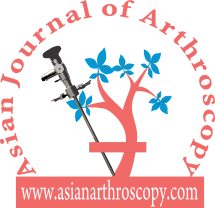Intraoperative Graft Contamination – What Options Do We Have?
Parag Sancheti, Sachin R Jain, Ashok Shyam
Volume 1 | Issue 1 | April – Jun 2016 | Page 35-37
Author: Parag Sancheti [1], Sachin R Jain [1], Ashok Shyam [1],[2]
[1] Sancheti Institute for Orthopaedics & Rehabilitation, Pune, India
[2] Indian Orthopaedic Research Group, Thane, India
Address of Correspondence
Dr Parag Sancheti
Sancheti Institute for Orthopaedics & Rehabilitation, Pune, India
Email: parag@sanchetihospital.com
Abstract
Background: Accidental graft contamination is not uncommon in a high volume centers practicing ligament reconstruction surgeries. There are several techniques of disinfecting the graft to prevent septic arthritis postoperatively. Aim of this review is to identify the different options of appropriate disinfectant and also the time interval for immersing the graft in the disinfectant solution for contaminated ACL graft.
Material and methods: MEDLINE, Pubmed and extensive searches of major arthroscopy journals identified several studies regarding graft contamination and its disinfection protocol which was used in this study.
Conclusion: 4% chlorhexidine or 10 % povidone iodine seem to be most effective in disinfecting contaminated graft after immersion for 3 min and 15 min respectively. All sutures should be removed prior to disinfection and proper antibiotic cover and follow up should be done to prevent any residual infection.
Keywords: Anterior cruciate ligament reconstruction, graft contamination, antiseptics
Introduction
Anterior Cruciate Ligament (ACL) reconstruction is the most common ligament reconstruction surgery done in the world(1). There is always a possibility of inadvertent graft contamination by dropping it accidentally on floor(2). 25% of fellows in sports medicine report at least one such event(3). Various treatment modalities exist to prevent postoperative infection due to contaminated graft such as cleansing alone with normal saline, immersion in 4 % chlorhexidine and bacitracin solution, 10% povidone – iodine solution, sodium hypochlorite solution or antibiotic solution wash (2,3,4,5). Other option is to discard the graft and harvest another graft or use an allograft, but this causes donor site morbidity or increased cost associated with use of allograft(3). Floor cultures can be simultaneously obtained to find out the organism grown during contamination.
Methods
MEDLINE, Pubmed and extensive searches of major arthroscopy journals identified several studies regarding graft contamination and its disinfection protocol which was used in this study. Aim of this review was to find out the epidemiology of graft contamination, different agents used for decontaminating the graft and its efficacy, organism grown in floor or contaminated graft culture, cleaning protocol for hamstring graft and for bone patellar bone tendon graft, preventing measures for graft contamination and finally treatment with antibiotic protocol postoperatively.
Discussion
Around 25% surgeons have reported to have a contaminated graft at least once with 35% of these surgeons performing at least 100 ACL surgeries annually (1). Sterilization by autoclaving destroys the material properties of collagenous tissue, so other sources of nondestructive disinfection must be considered (9).
Barbier et al(2) compared 4 groups after dropping graft on the floor with cultures taken after immersion in antiseptic solution for 15 min – 4 % chlorhexidine gluconate solution (group 1), 10% povidone–iodine solution (group 2), sodium hypochlorite solution (group 3) and (group 0) was cultured without being exposed to any solution. They found that floor swab cultures were positive in 96% of cases and rate of contamination was 40% in group 0, 8% in group 1, 4% in group 2, and 16% in group 3. There was a significant difference between groups 1 and 2 and group 0 (p < 0.05) but not between groups 3 and 0. They concluded both 4% chlorhexidine as well as povidone iodine solutions are effective in treatment of contaminated graft. Sodium hypochlorite is not so effective with this respect. Molina et al.(8) found that 58% of the dropped grafts had positive cultures and also, 4 % chlorhexidine and double antibiotic solution (neomycin and polymyxin B) successfully decontaminated dropped native ACLs at a rate of 98 and 94 %, respectively. The time duration used by different surgeon varies for different surgeons which ranges from 90 seconds to 30 minutes(1). The most common antiseptic solution chosen by the high volume surgeons was chlorhexidine(1). However, when povidone– iodine solution was used, 24 % of the ACL graft had resulted in positive cultures. Graft can be washed for a period 3 min to reduce undue delay of the surgery(3). Their limitation was that the graft was kept in the sterilizing agent for 90sec and then sent for culture. Pasque et al(10) suggested getting the graft off of the floor immediately, removing any suture material in the graft, cleansing the graft for 15 to 30 minutes each in chlorhexidine and triple antibiotic solution, followed by a normal saline rinse is associated with very less chance of infection. Casalonga et al. (11) followed the outcome of four patients in whom the B-T-B graft dropped onto the floor was re-implanted after decontamination with topic antibiotics. The grafts were soaked in rifamycin and then gentamycin for 10 min each along with postoperative antibiotics for 15 days. There were no complications or postoperative infections, and all patients were able to return to previous sport level. Cooper et al (12) after soaking contaminated grafts in antibiotic solution for 15 min suggested it may reduce the incidence of positive cultures but it may still result in a 30% incidence of nonsterile grafts. Floor cultures most commonly grow coagulase-negative Staphylococcus, bacillus species and diphtheroids(13, 3). The limitation of this study that it was done in cadavers. Plante et al (3) suggested that immediate graft retrieval (<5 sec) did not affect the rate of contamination when compared to fifteen-second exposure (33 vs. 23 %). Sobel et al(14) suggested that structural properties of human patellar tendon allografts are not significantly affected by soaking in 4% chlorhexidine gluconate for 30 minutes. Stanwood et al(1) stated that 71% of surgeons who experienced graft contamination cleansed the graft, and 75% contaminated grafts were cleansed and the ACL reconstruction proceeded as planned. In 18% an alternative autologous graft of contralateral patellar tendon or ipsilateral hamstrings was used to replace the contaminated graft and in 7% of cases, an allograft was used.
In general, the rate of contamination of graft if dropped on floor is between 63 to 96 % and the contaminant grown in culture is staphylococcus(12,8,10, 2). Also, the time interval of dropping the graft and its retrieval doesn’t influence the culture as the different studies have compared the different time interval i.e. 15 sec, 3 min which found similar growth(2). This suggests a definite need of treatment of graft after contamination irrespective of the time duration. Chlorhexidine and povidone iodine solutions both are broad spectrum antiseptics and chlorhexidine is activated in less than 1 min and 10% povidone-iodine takes a longer time to activate with increased activity after 5 min(2). This suggested the need of different immersion time required to disinfect the graft in different solution, in 4 % chlorhexidine solution 3 min may be adequate(8) whereas it may require upto 15min immersion in 10% povidone-iodine solution(2). Soaking of grafts in antibiotic solutions might increase the risk of multiresistant organism being selected(2) also there is 30% risk of getting non sterile graft(12). If a sutured hamstring graft is contaminated then all the sutures are to be removed before immersion in a disinfectant solution(2).
Jones et al(15) studied the mechanical properties patellar tendon allograft subjected to chemical sterilization(BioCleanse) and found that preimplantation mechanical properties of BPTB allografts treated with BioCleanse are not significantly different from those of untreated controls.
Other than dropping of graft on floor, graft contamination during surgery may occur at various steps of surgery before implantation. Hantes et al (6) studied various sources of contamination of hamstring and patellar tendon autograft. Three tissue samples were obtained for culture from each graft at different time-intervals during graft preparation process, during graft preparation completion and during graft implantation. In addition, the erythrocyte sedimentation rate and the C-reactive protein level were evaluated preoperatively and on the third, seventh, and twentieth postoperative days. Authors concluded that a high rate (12%) of autograft contamination can be expected during autograft preparation for anterior cruciate ligament reconstruction. The contamination rate is almost equal for both bone-patellar tendon-bone and hamstring tendon autografts which was confirmed with normal ESR and CRP reports. However, there was no evidence of postoperative infection with intraoperative contamination results in their series. They further suggested that no excessive antibiotic is required for positive cultures and no evidence of clinical signs of infection. Postimplantation of the contaminated graft after disinfection, it is advised to treat the patient with IV antibiotics and/or oral antibiotics for 1 or 2 weeks. Also, a close watch to be kept until 6 weeks of surgery ifany signs of infection develops(10).
There is a very high chance of contamination of graft when a new staff is given the responsibility of holding graft or surgeon goes to a new setup(10). To prevent this, surgeon should personally get the graft from the time of harvest till getting it on the preparation table. Similarly, new staff or resident who is preparing the graft should be adequately trained and strictly monitored to prevent dropping of graft. Finally all the OR personnel should realize the importance of surgery and be careful at all times especially while transfer of graft from preparation table to implantation site and vice versa.
Conclusion
4% Chlorhexidine with or without bacitracin is the best solution for disinfection of contaminated graft. Graft has to be minimum kept for 3 min immersed in the solution for proper disinfection. If 10% povidone-iodine is to be used graft has to be immersed at least 15 minutes. Earlier the retrieval of graft, better the disinfection as shown comparison between less than 5 second retrieval and 15 sec graft retrieval from floor. All suture material must be removed while disinfecting the graft. Post implantation, antibiotics have to be given for a period of 1 or 2 weeks and have to be followed for at least 6 weeks
References
- Stanwood W, Levine WN, Ahmad CS. A Survey of Sports Medicine Specialists Investigating the Ligament Grafts. 2005;21(11):1348–53.
- Barbier O, Danis J, Versier G, Ollat D. The Knee When the tendon autograft is dropped accidently on the fl oor : A study about bacterial contamination and antiseptic ef fi cacy. Knee [Internet]. Elsevier B.V.; 2016;22(5):380–3. Available from: http://dx.doi.org/10.1016/j.knee.2014.07.027
- Plante MJ, Li X, Brown MA, Busconi D, Deangelis NA. Evaluation of sterilization methods following contamination of hamstring autograft during anterior cruciate ligament reconstruction. 2013;21(3):696–701.
- McAllister DR, Parker RD, Cooper AE, Recht MP AJ. Outcomes of post-operative septic arthritis after anterior cruciate ligament reconstruction. Am J Sport Med. 1999;27:562–70.
- Schollin-Borg M M elsson, Micha¨ elsson K RH. Presentation, outcome, and cause of septic arthritis after anterior cruciate ligament reconstruction: a case control study. Arthroscopy. 2003;19:941–7.
- Me H, Gk B, Se V, Giotikas D, Petinaki E, Kn M. Autograft Contamination During Preparation for. 2008;760–4.
- Stanford R, Solomon M, Levick M, Kohan L, Bell S. Sterilization of Contaminated Bone-Tendon Autografts Using 10% Povidone-Iodine Solution. Orthopedics. 1999;22:601–4.
- Molina ME, Nonweiller DE, Evans JA, Delee JC. Contaminated anterior cruciate ligament grafts: the efficacy of 3 sterilization agents. Arthroscopy. 2000 May-Jun;16(4):373-8.
- Davis KW, Stauderman WE, Mayfield J WJ. Gamma radiation dose setting and auditing strategies for sterilization of medical devices. In: Gaughran ERL, Morri-of medical products. Montreal. Steriliz Multiscience Publ Ltd. 1981; Vol 2:34-102
- Pasque C, Geib T. Intraoperative Anterior Cruciate Ligament Graft Contamination. 2016;23(3):329–31.
- Casalonga D, Ait Si Selmi T RA et al. Peroperative accidental contamination of bone-tendon-bone graft for the reconstruction of the anterior cruciate ligament. Report of 4 cases. Rev Chir Orthop Reparatrice Appar Mot. 1999;85(7):740–3.
- Cooper DE, Arnoczky SP, Warren RF. Contaminated Patellar Tendon Grafts : Incidence of Positive Cultures and Efficacy of an Antibiotic Solution Soak-An In Vitro Study. 1991;272–4.
- Richard D. Parker, Evan J. Bachner, Michael J. Dul, Dirk Treleven, Matthew E. Levy and PP. The Scientific Basis for the Management of Contam- inated Bone-Tendon Grafts: The Serial Dilution/ Mechanical Agitation Technique. Arthroscopy. 1993;9(3):354.
- Sobel AD, Hohman D, Jones J, Bisson LJ. Structural Properties of Human Patellar Tendon Allografts. YJARS [Internet]. Elsevier Inc.; 2016;28(12):1862–6.
- Jones DB, Huddleston PM, Zobitz ME, Stuart MJ. Mechanical Properties of Patellar Tendon Allografts Subjected. 2007;23(4):400–4.
| How to Cite this article:. Sancheti P, Jain SR, Shyam AK. Intraoperative Graft Contamination – What Options Do We Have? Asian Journal of Arthroscopy Apr- June 2016;1(1):35-37 . |











